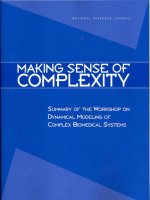Making Sense of Strategy (2001)
Bạn đang xem bản rút gọn của tài liệu. Xem và tải ngay bản đầy đủ của tài liệu tại đây (962.8 KB, 108 trang )
TEAMFLY
Team-Fly
®
American Management Association
New York
•
Atlanta
•
Brussels
•
Buenos Aires
•
Chicago
•
London
•
Mexico City
San Francisco
•
Shanghai
•
Tokyo
•
Toronto
•
Washington, D. C.
This publication is designed to provide accurate and authoritative information in regard to the sub-
ject matter covered. It is sold with the understanding that the publisher is not engaged in render-
ing legal, accounting, or other professional service. If legal advice or other expert assistance is
required, the services of a competent professional person should be sought.
Library of Congress Cataloging-in-Publication Data
Manning, Anthony D.
Making sense of strategy/Tony Manning.
p. cm.
Includes bibliographical references and index.
ISBN 0-8144-7156-0
1. Strategic planning. I. Title.
HD30.28.M352 2002
658.4’012—dc21 2002016454
Publication © Zebra 2001
Text © Tony Manning 2001
All rights reserved.
Printed in the United States of America.
First published in 2001 by Zebra, an imprint of Struik Publishers, PO Box 1144, Cape Town 8000,
South Africa. AMACOM edition published in 2002 by arrangement with Struik Publishers.
This publication may not be reproduced, stored in a retrieval system, or transmitted in whole or in
part, in any form or by any means, electronic, mechanical, photocopying, recording, or otherwise,
without the prior written permission of AMACOM, a division of American Management
Association, 1601 Broadway, New York, NY 10019.
Printing number
10 9 8 7 6 5 4 3 2 1
Special discounts on bulk quantities of AMACOM books are available to corporations,
professional associations, and other organizations. For details, contact Special Sales Department,
AMACOM, a division of American Management Association, 1601 Broadway, New York, NY
10019. Tel.: 212-903-8316. Fax: 212-903-8083.
Web site: www.amacombooks. org
INTRODUCTION 1
1 CONTEXT 7
What’s going on? 10
Remember life cycles? 12
Beating the odds 15
Two schools of thought 17
2 CONCEPTS 21
Shareholders first 23
Making a difference makes the difference 24
The First Principles of Business Competition 26
Hard choices 27
Winning votes 29
A systems view of value delivery 32
Strategy and spirit 35
Strategy is change management 40
Action learning for culture change 42
Beyond culture to climate 44
Raise your organization’s “strategic IQ” 46
The quest for meaning 47
New assumptions 49
3 PROCESS 51
A questioning process 51
Six abilities that give winners the edge 52
Does your business logic add up? 54
The big test 57
A systematic approach to planning 61
Step 1: Define your purpose 63
Step 2: Define your business recipe 65
Design your business model 66
Step 3: Clarify your organizational character 70
Step 4: Define your goals, priorities, and actions 71
Step 5: Craft your strategic conversation 76
From intentions to action in 30 days 77
CONCLUSION 81
THE 20 STRATEGY QUESTIONS 85
NOTES 89
RECOMMENDED READING 91
INDEX 93
PRINCIPLES
1. If you don’t make a difference, you don’t matter.
2. You can’t make a difference to everyone.
3. Strategy must enable your organization to make a difference that matters
to a critical mass of the “right” customers.
4. Strategy connects the purpose and values of your organization with those
of its customers and other external stakeholders.
5. It may be easy to clone a product, but it’s impossible to clone a communi-
ty. So a vital goal of strategy is to create and sustain a unique community.
6. Purpose and values hold a community together, drive teams to seek their
potential, and provide the context in which individuals will volunteer
their imagination and spirit.
7. Shared ideas lead to shared meaning. The more openly and honestly ideas
are shared, the greater the level of trust will be, the more efforts will be
aligned – and the more ideas will emerge.
8. People value work that makes them feel valued. When they make strategy,
they matter. And they own the results, so effective execution is more likely.
9. Strategic management is conversation. It informs, focuses attention and
effort, triggers fresh insights, lights up the imagination, energizes people,
and inspires performance.
10. Strategic conversation provides a context for personal and group learning.
Your message must be compelling, simple, clear, and believable, or you
won’t sell it. It must also be complex and challenging, or no one will buy
it. And it must be repeated with relentless consistency.
INTRODUCTION
INTRODUCTION
L
et’s cut the b.s. and cut straight to the chase. Strategy is not rocket science.
It’s about listening to customers, asking some pretty simple questions,
making some choices, and getting people to support your decisions.
Strategy is the ultimate responsibility of every business leader. Companies
succeed when they get it right and fail when they get it wrong. The fact that
more companies fail than succeed says that something is very wrong indeed
with the state of strategy. It’s also an indictment of leadership.
This new century is a time of extraordinary complexity, opportunity, and
risk. Business is a 24/7 activity. Markets are global, competitors are increasing-
ly hostile, and change occurs faster than at any other time in history. Managing
almost any organization gets harder by the minute. There’s too much to do and
too many new challenges. Things need more thought, but there’s less time to
turn ideas into action.
Smart people have been writing about management for close to 100 years,
and they’ve offered “solutions” to just about every business problem. Yet exec-
utives everywhere still seek The Answer to a simple question:
How do you choose what to do . . . and how do you get it done?
Or, to put it differently, what is the best way to take your company from here to
the future and make a bundle of money on the way?
Whether you think of your company as “old economy” or “new economy,”
as “bricks-and-mortar,” “B2B” (business-to-business), “B2C” (business-to-
consumer), or whatever, the race for tomorrow’s customers and profits hinges
on two things: business model design and implementation capability. So best you
wrap your mind around what really matters and get busy with it fast.
introduction 1
TEAMFLY
Team-Fly
®
Best, too, that you sort through your toolkit and quickly toss out some of the
junk that’s taking up your time and attention. Like most executives, you prob-
ably have stuff in there that weighs you down and stops you getting your job
done. Like most organizations, yours is probably jammed with meetings, buzz-
words, workshops, projects, studies, and reports that add precisely zero to your
bottom line.
Ironically, one trigger for trouble is the management know-how industry,
which in recent years has caught fire. It preaches innovation, yet is a major
cause of organizational logjams.
Every discipline—art, medicine, mathematics, or whatever—evolves over
time. Now and then a quantum shift occurs that changes the game: cubism,
penicillin, Einstein’s theory of relativity. But management thinking barely
moves. Concepts are recycled, repackaged, and pumped back onto the market
as brilliant breakthroughs, as the ultimate success formula, as the definitive
solution. At the very time that we’re warned over and over that more of the
same is the kiss of corporate death, in reality it’s the order of the day. And those
who warn about it most are often its most ardent advocates.
Managers try hard to create the impression that they’re sensible, logical, and
practical. Yet they’re suckers for snake oil.
Business school academics churn out articles that often become books and
are then leveraged into audio and videotapes, CDs, and seminars and lucrative
speaking assignments in exotic places. Management consultants boast about
“thought leadership” and promise to bring “best practices” to their clients’
businesses. But you don’t have to be an expert to make hay in the field of man-
agement ideas.
Yachtsmen, football coaches, and orchestra conductors make fortunes shar-
ing their experience with people trying to make a buck from auto assembly,
microchip fabrication, or commercializing software code. If you’ve crossed the
Sahara on a motorbike, climbed Mount Everest (or maybe even a lesser moun-
tain like Annapurna or Kilimanjaro), or spent a year with a mystic in Nepal,
you’re in business.
2 making sense of strategy
Books for managers fly faster and in greater numbers onto the shelves. Some
have serious titles and clunky prose that ensure that most readers won’t get
past Chapter 1. Others are catchier and jammed with bullet points and check-
lists.
Many best-sellers of the past two decades have been written as if for
idiots. Parables are popular, and “Bill” and “Mary” feature in lots of them,
along with mentors like “The Executive.” The heroes of one winner are “little
people” and a couple of mice. And there are any number of titles promising
the wisdom of dolphins or foxes or wolves; the inspiration of eagles;
lessons from some ancient Japanese warrior, Bushmen hunters, the Marines,
or a trendy Californian chef; or insights from survivors of aircraft crashes,
cancer, or a cocaine habit.
Most of the people I talk to complain that busy-ness is killing them. They
have too much to do, and too little time. Since this is the Information Age, they
naturally all suffer from information overload. Yet most management books are
designed to add to their woes. They’re dense with case studies, anecdotes, and
quotes from famous executives. And who has time any more to plow through
300 or 400 pages of turgid theory?
This book is the antidote.
It may be the last business book you’ll ever need to read. It certainly should
be the first. For it tells you everything you need to know about strategic man-
agement, yet you can read it in less than an hour. (So that leaves you the rest of
your life to actually get things done!)
Making Sense of Strategy is based on the latest management thinking, as well
as my own experience of what actually goes on in companies and what really
works. It captures views that have developed over the past century, from writ-
ers listed in the bibliography and from many others, too. Some of the ideas have
appeared in my earlier books, and I use them here because they have been
extensively “field-tested” over a long period.
Unlike other books, which tend to focus on one aspect of management or
another, this one presents a holistic view. It gives you an original—and effec-
introduction 3
tive—way of making the difference that matters. In addition to its back-to-
basics approach, it’s unique for seven reasons:
1. It makes strategic planning a sensible and powerful business tool at a time
when many people say that planning is a relic of the past and a waste of time
in a chaotic, fast-changing world.
2. It builds on a wide range of business concepts, including value chains and
value constellations, core competence, activity systems, co-opetition, and
hypercompetition to give you a thoroughly practical way of thinking about
your strategy.
3. It weaves ideas from many fields—strategy, systems theory, chaos and com-
plexity, human resources management, change management, total quality
management, lean thinking, leadership, and others—into an integrated and
understandable process.
4. It helps you focus on what really matters, thus avoiding the dreaded corpo-
rate disease of “interventionitis” (which paralyzes people by overwhelming
them with initiatives and projects—customer service today, quality tomor-
row; a dash of cost cutting; a stab at team building; a dose of reengineering;
or a sudden infatuation with e-commerce).
5. It provides a step-by-step approach to creating, implementing, and evaluat-
ing strategy. You can also use the tools in any combination that meets your
needs.
6. The emphasis is on growth through action—on getting results fast, on learning
by doing, and on making strategy and change simultaneous activities.
7. You can actually do something with it!
Like politics, business is the art of the possible. Making Sense of Strategy will help
you make things possible. Whether you’re a practicing executive, a student or
teacher of management, an investor, an investment analyst, or a business jour-
nalist, this book will help you make a difference.
There are many questions in the pages that follow. You can use them to diag-
nose the current health of your organization by thinking about them in the pre-
4 making sense of strategy
sent tense. Or you can use them to create tomorrow’s strategy by considering
what might be. Both approaches are worthwhile. And remember—the first
answer is seldom the only one or the best one. So keep digging. The more you ask,
the more likely you are to get past the superficial stuff and hit gold!
TONY MANNING
P.S. In the spirit of good conversation, please let me know what you think of
Making Sense of Strategy. You can e-mail me at My
website—www.tonymanning.com—has lots of other information you may find
helpful.
introduction 5
This Page Intentionally Left Blank
CONTEXT
1
CONTEXT
T
he purpose of a leader is to create a context in which people will perform
to their potential. This “mental space” is where they discover and test
themselves and where they reveal (or conceal) their magic. Context is a
product of conversation.
Organizations, then, are managed conversations. People inside them talk to
one another all day long about what they must do and how they do it. They also
talk to a variety of outsiders—customers, suppliers, government, and so on. If
the right people are involved and if these conversations are open, honest, con-
structive, and positive, good things happen. But if key people are left out, and
if the conversation is blocked, devious, destructive, or negative, trouble is
ensured. “Nourishing conversation” is vital to success. “Toxic conversation”
guarantees failure.
In shaping their context, strategists must do three things:
1. Make choices. You have to decide which customers and markets to chase,
what products or services to offer, and how to apply your resources.
2. Win “votes.” You have to exist in harmony with many stakeholders, and
you have to persuade some of them (especially your people, your suppliers,
and your customers) to volunteer their imagination and spirit to your cause.
3. Build capacity. You have to develop your organization’s “strategic IQ” so
that your people can think and act appropriately as you head into a surpris-
ing future.
The 228 words you’ve just read tell you why some companies win and others
lose. They explain why so many change efforts fail to deliver the expected
results and why companies struggle to survive and grow. And they highlight
what leaders must do to make a difference.
context 7
Choices, commitment, and capacity are not the products of machines. All
result from people talking to one another. All come from that everyday activi-
ty—conversation—that we mostly take for granted and often use carelessly
because it’s such an integral part of our lives.
Much of our daily conversation is a default activity: it just sort of happens. By
contrast, “strategic conversation” is no accident. It’s a deliberate process and the
No. 1 leadership tool. All else rests on it. So you need to think about it system-
atically, craft it carefully, and use it purposefully.
The first task of a leader is to provide a clear point of view—“There’s the hill
we’re aiming at . . . these are the results we want . . . this is how we should con-
duct ourselves . . . here are our priorities . . . this is what we’ll do to get where
we want to go.” This is the context in which people work.
The ongoing task is to focus and inspire them. We all know that “what gets
measured gets managed.” But we conveniently forget that it’s only what is
spoken about—constantly, passionately, consistently—that will be either mea-
sured or managed. Talk about the right issues in the right way to the right peo-
ple, and extraordinary things happen; but get the conversation wrong, and
you’re sunk.
When a leader speaks constantly about customer service, that’s what people
pay attention to. If he or she speaks fanatically about costs—or productivity,
teamwork, innovation, or whatever—then those are the things that count.
Just as language influences the way a society works, so does it impact on the
behavior—and the bottom line—of a company. But when did you last hear
managers say, “Let’s talk about what we need to talk about” or, “Let’s think
about the words we use around here”? Probably never. After all, they have bet-
ter, cleverer things to do. (And maybe there’s a communications manager who
handles communication!)
Management tools come and go with mostly disappointing results because
the strategic conversation that should be their base is missing or ineffective.
Executives work on “superstructure,” when their foundations are weak. They
call on sophisticated concepts when the basics are not in place.
8 making sense of strategy
If you were to ask almost any top executive to list their three most critical concerns,
you’d probably hear: strategy, leadership, and change management. If you then
looked for answers to these issues, you’d find little common ground among them.
They’re treated as three distinct challenges. Yet they interlock and overlap so
tightly it’s virtually impossible to deal with them separately and still be effective.
The language problem in business begins when you ask people what they
understand by strategy. Here are some common answers:
“It’s a plan for taking your company into the future.”
“Vision, mission, values, and action plans.”
“A long-term view of where you’re headed.”
“A SWOT analysis.”*
“The analysis you do to make sure you hit the numbers.”
Now ask whose responsibility it is, and the answer is almost always the same:
“Top management!”
Strategy, it seems, is something that a few smart and powerful people think
about. Then they pass their wisdom down the line in the form of instructions,
and the drones get busy.
Or that’s the theory.
In real life, the folks at the top might indeed think about “the big issues.”
They might agree on “big, hairy, audacious goals.” And they might produce
terrific documents and slide shows and make stirring speeches. But then
something goes wrong.
Things change in the world around them. There’s a surprise a minute—and
not all of them pleasant. Their people don’t do what they’re told. Their great
plans produce mediocre results. Even if by some miracle they manage to do
what they intended, it turns out to be wrong.
context 9
* Strengths, weaknesses, opportunities, threats, an exercise that forms part of just about every planning
workshop and fills lots of flipchart pages, yet seldom leads to radical thinking. More often, the same
issues get recycled year after year and never go away.
Most companies have a shorter life than most people. For all the time, ener-
gy, and money that goes into making them survive and thrive, the results are dis-
appointing. Reengineering cuts costs . . . but kills employee loyalty. Customer
service improves . . . but customers think it’s worse. You spend fortunes on
change and improvement . . . but three out of four change efforts don’t work as
they should. You think you’ll put your company on steroids with a new strate-
gy . . . and the damned thing shrivels up and dies on you!
WHAT’S GOING ON?
John Lennon put it perfectly when he said, “Life is what happens when you’re
busy making other plans.”
Life doesn’t wait for your market analysis, your consultant’s advice, or your
500-page plan. Nor does it stop while you rethink, reengineer, or reorganize. It’s
a dynamic, complex, surprising, exhilarating, wonderful—and sometimes
shocking—process that sweeps you along . . . or sweeps you away.
This gives you a simple choice: either you deal with things as they are, or you
close your eyes to reality and plan for things as you’d like them to be.
If you think that’s a no-brainer, ask yourself why so many companies get
into trouble so quickly, and so few enjoy a long and happy life. It can’t be
because most executives are dimwits. It has to be that:
•
They have their heads in the clouds, from where they happily ignore what’s
going on around them.
•
They interpret environmental signals to suit their own mental models, rather
than looking the facts and the future right in the eye and doing what they
must to adapt and survive.
•
They fail to build the internal organizational capabilities that fit changing
external realities, so though they may be successful for a time, their perfor-
mance sooner or later slumps.
•
They can’t get things done.
10 making sense of strategy
In theory, corporate evolution is a tidy matter that’s taken care of by top man-
agement. In practice, it’s a messy process. A lot of it happens way out at the
edges, far from the planners, the scenarios, and the spreadsheets, where “low-
level people” serve customers, make stuff, fix things, punch buttons, sign doc-
uments, interpret events, and otherwise do their own thing.
People at the top don’t have “line of sight” to the real world. The rest don’t
have “line of sight” to the reasoning behind their organization’s strategy. This
blindness makes both groups less effective than they might be.
The bosses think they’re firmly in charge. In fact, they’re bounced around by
issues and events. Hard as they try to shape strategy, it’s to a great extent
shaped for them. While they imagine themselves as being all-powerful, the
world around them goes on with its business—and molds the context for their
business decisions and actions.
Two of the hottest business themes in recent years have been core compe-
tence and chaos theory. Volumes have been written about both, and they’re
favorites on the conference scene. Yet all you need to know is this:
•
You have to be exceptionally good at something. You have to build strengths
today for tomorrow. And since all capabilities hinge on the “mind of your
organization,” it’s your most valuable asset and your best weapon. The abil-
ity to anticipate, imagine, and innovate is the most critical competence of all.
The more widely spread this competence, the better. And the best way—pos-
sibly even the only way—to develop and leverage it is through strategic con-
versation.
•
You don’t have to know everything. The world is inherently unpredictable.
Control freaks get hurt. You cannot get to the future in a straight line. But
you can take advantage of surprises by involving your people in a rich,
robust strategic conversation that makes every one of them the eyes, ears,
and brain of your organization. When you’re all alert and learning, when
you’re sharing and testing ideas, and pushing and inspiring one another,
chaos becomes fuel for growth. Serendipity becomes a spark for change.
Surprises energize you.
context 11
TEAMFLY
Team-Fly
®
Perhaps the most difficult thing for any leader to accept is the tension between
freedom and control. Disregarded, it causes awful problems. Embraced, it
brings remarkable results.
Strategy demands discipline. Leaders need to be firm and clear about what
they expect. But beware of strangling your organization. The context you create
will imprison or liberate people. It’ll either give them courage and confidence
and build their competence, or it will convince them that ordinary is OK. It’ll
either empower them to do roughly the best thing most of the time, or it will
ensure that they underperform constantly and screw up regularly. (Which
means that you have to keep them on a short leash and waste your own time
mopping up behind them.)
REMEMBER LIFE CYCLES?
By now, every executive knows about life cycles. Yet for some reason, most for-
get about them or pretend they apply only to someone else. But they affect all
of us, and we ignore them at our peril.
Every living thing goes through a fairly predictable process of birth, growth,
maturity, decline, and death. Nothing is forever. Companies are no exception.
But whereas other organisms—people, animals, plants—age and die no matter how
well they adapt to their external environment, the lifetime of organizations can be
extended. Those that adapt best will outperform and outlive their competitors.
Companies are born into a changing world, and it keeps changing. The con-
ditions that exist when an entrepreneur hangs out his or her shingle don’t last
for long. So the challenge is to extend the time between a company’s first breath
and its last gasp (Figure 1-1).
The only way to do this is to continually reinvent your organization so that
it “fits” the emerging conditions around it, to create new “S-curves” that keep
your sales and profits on an upward path, defying the gravitational pull of
“more of the same” (Figure 1-2).
12 making sense of strategy
FIGURE 1-1 Every living thing goes through a fairly predictable life cycle. Most companies die shortly after
birth. On average, those that survive will last about 30 years. A few last well over 100 years.
FIGURE 1-2 Organizations can rejuvenate themselves through improvement and innovation—by doing the
same things better and by doing different things. But they must at all times live in harmony with the world
around them.
context 13
ECONOMY
POLITICS
SOCIETY
TECHNOLOGY
CUSTOMER
COMPETITOR
RESULTS
TIME
GROWTH
TIME
Survival and success depend on innovation. So strategy has to be about:
1. Being alert to change (
ANTICIPATION).
2. Seeing opportunities to offer something different and new (
INSIGHT).
3. Dreaming up new ways of doing it (
IMAGINATION).
4. Doing it consistently and to the highest standards (
EXECUTION).
The question, of course, is when and what do you change? (How comes later.)
These are always risk decisions. Much of what your company does today might
have great value for a long time yet. To drop some of your products now could
be ill advised. To add bells and whistles to your services might add costs but
bring no immediate benefits. To reengineer your processes might cause more
problems than it’s worth. To change your advertising campaign might be a sure
way to destroy your brand in the marketplace.
Change for the sake of change is stupid. There has to be a business case for
it. But when the case is clear, don’t resist or even hesitate. (It’s insane to do more
of the same while expecting different results!) However strong your inclination
may be to hold your course, there comes a time when you have to act. Often a
window of opportunity opens for only a brief moment. Seize that moment, and
you gain advantage; miss it, and you may never recover.
For some businesses, the smartest thing to do is to strive constantly and
aggressively for disruptive strategies—to change not just the rules of their game
but the game itself. In other cases, the best way forward is to stay with the
basics, to hone them continuously, to execute meticulously, and to make sub-
stantial changes rarely.
As a general principle, every company should aim for both improvement
and radical change. This is hard to do, but it’s also hard for competitors to
match. When you present a constantly moving target, they’re pressed to keep
up with you. And the more things you change, and the faster you do it, the better
your chances of staying out front. In a street fight, a surgical strike may save
your life but a “flurry of blows” keeps your enemy off balance and sets you up
for the big hit.
14 making sense of strategy
BEATING THE ODDS
Business is always a gamble. It involves a lot of guesswork. There are few cer-
tainties and many possibilities.
While there’s plenty of information about most things today, the future is a
mystery. No one knows what’s going to happen an hour from now, let alone in
six months or ten years. The best you can do is make some assumptions based
on what is already going on.
Beware, however, of then assuming that events will unfold in a straight line
to the future. Current trends may signal future ones but do not guarantee them.
So although you may gather reams of documents, listen to dozens of experts, or
commission tons of research, you sooner or later have to do what feels right. Put
bluntly, you have to go with your gut.
Some people seem to have an inborn ability to make the right calls (or
they’re just luckier than most). Experience does hone judgment (though it may
just stop you taking a lot of chances that might have paid off). But the fact is, we
all wind up guessing.
In the real world, success in most fields involves a lot of bumbling. You
might say that we fall (and fail) our way into the future. So picking yourself up
fast—recovering, learning, and moving on—is the real gift. Action is a surer
way to the future than endless analysis. Surviving to fight another day is
smarter than committing suicide with a single stroke.
Yesterday’s strategic planners dreamed about big S-curves with five- or
ten-year horizons. In some industries this still makes sense, because you have to
invest hefty sums and the payoff is way off. Besides, laying big bets may
bring big wins—in fact, may be the only way to the jackpot. And macho leaders
are admired for their boldness—which may inspire valuable confidence. So
obviously you should have a long-term view of where you want to go. And
obviously you should aim for the single S-curve that will ensure leadership. But
be aware that one “visionary” move can sink you.
context 15









